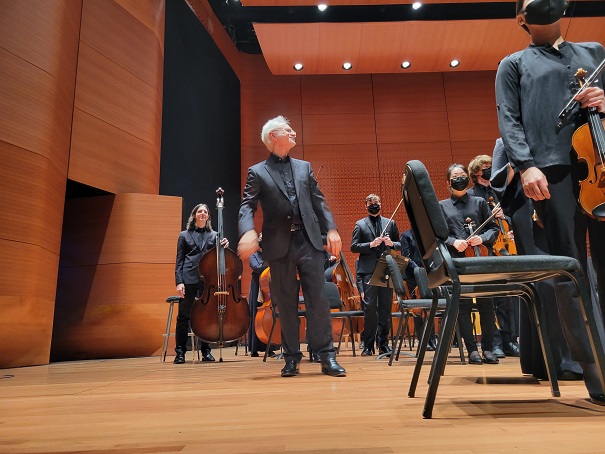Concert Diary: John Adams Conducting the Julliard Orchestra
November 30, 2021
New York, N.Y.
John Adams is one of America’s most prominent composers, but like many composers before him, he also does a considerable amount of conducting, and on November 22, Adams led the young musicians of the Juilliard Orchestra in a concert of the fairly recent, the somewhat older, and the older still.
The fairly recent work was Steve Reich’s Three Movements from 1986, which begins with the same kind of pulsing that Reich introduced in Music for 18 Musicians a decade earlier. It’s like a mystical passageway into the music, the shifting timbres peeling away layers of concealment until a syncopated figure is introduced that made me want to dance. The second movement is quite different: a slow jagged rhythm in the strings and woodwinds, soon joined by bass drum, marimba, and vibraphone, which are left alone as the strings and woodwinds drop out. The fast finale breaks in with a more insistent pulse, rhythmic figures start flying all around, and it rises to quite a dramatic climax.
The orchestra in Three Movement is arranged much like Béla Bartók’s Music for Strings, Percussion, and Celesta from 1936, so it seemed reasonable for John Adams to continue the concert with this work, which was evening’s highlight. I love this music, and it’s great to see it in concert: The long slow fugue of the first movement gives the work an eerie feel from the very beginning, and I love the celesta arpeggios later on. Simple, yet so effective.
The first of the two Allegro movements in Music for Strings, Percussion, and Celesta introduces Bartók’s Hungarian-influenced rhythms with an exhilerating interplay between the piano, timpani, xylophone, celesta, harp, and strings, including soft and very hard pizzicatos. The Adagio is the movement that is truly amazing and creepier still, with its timpani and string glissandi, and more shivery celesta arpeggios. After that the Allegro finale is just sheer fun.
Needless to say, John Adams and the Juilliard Orchestra handled all of this marvelously. Here’s Adams during curtain calls with some of the string section of the orchestra:
Following intermission was a work whose inclusion in this program surprised me: the Symphony No. 1 in E Minor by Jean Sibelius, composed in 1899, a work with which I was unfamiliar. I suspect that John Adams works under the dictum that old works should be performed as if they were new, so I was more than usually focused on what might be characterized as “modernist” elements in the music, and it didn’t fail me. The clarinet and typani opening was quite striking, followed by the sudden introduction of the strings, and the shifting moods reminded me of Mahler. There were more shifting moods in the second movement Andante: lyrical, majestic, pastoral, rambunctious. The third-movement Scherzo was quite fun with its timpani motif, slowing down for a pastoral Trio. The “quasi una fantasia” finale was also quite enjoyable, again often Mahleresque in its changing moods, with a surprisingly tragic finish.
